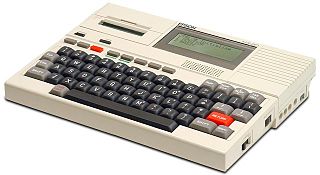Applesoft BASIC is a dialect of Microsoft BASIC, developed by Marc McDonald and Ric Weiland, supplied with the Apple II series of computers. It supersedes Integer BASIC and is the BASIC in ROM in all Apple II series computers after the original Apple II model. It is also referred to as FP BASIC because of the Apple DOS command FP used to invoke it, instead of INT for Integer BASIC.

Atari BASIC is an interpreter for the BASIC programming language that shipped with Atari 8-bit computers. Unlike most American BASICs of the home computer era, Atari BASIC is not a derivative of Microsoft BASIC and differs in significant ways. It includes keywords for Atari-specific features and lacks support for string arrays.

MSX is a standardized home computer architecture, announced by ASCII Corporation on June 16, 1983. It was initially conceived by Microsoft as a product for the Eastern sector, and jointly marketed by Kazuhiko Nishi, the director at ASCII Corporation. Microsoft and Nishi conceived the project as an attempt to create unified standards among various home computing system manufacturers of the period, in the same fashion as the VHS standard for home video tape machines. The first MSX computer sold to the public was a Mitsubishi ML-8000, released on October 21, 1983, thus marking its official release date.

The TI-99/4 and TI-99/4A are home computers released by Texas Instruments in 1979 and 1981, respectively. Based on Texas Instruments's own TMS9900 microprocessor originally used in minicomputers, the TI-99/4 was the first 16-bit home computer. The associated TMS9918 video display controller provides color graphics and sprite support which were only comparable with those of the Atari 400 and 800 released a month after the TI-99/4. The TI-99 series also initially competed with the Apple II and TRS-80.

The Timex Sinclair 2068, released in November 1983, was Timex Sinclair's third and last home computer for the United States market. It was also marketed in Canada, Argentina, Portugal and Poland, as Timex Computer 2068.
4-bit computing is the use of computer architectures in which integers and other data units are 4 bits wide. 4-bit central processing unit (CPU) and arithmetic logic unit (ALU) architectures are those that are based on registers or data buses of that size. A group of four bits is also called a nibble and has 24 = 16 possible values.

The VTech Laser 200 is an 8-bit home computer from 1983, also sold as the Salora Fellow, the Seltron 200 in Hungary and Italy, the Smart-Alec Jr. by Dynasty Computer Corporation in Dallas, Texas for the USA, the Texet TX8000A, and the Dick Smith VZ 200 and the VTech VZ 200.

The Enterprise is a Zilog Z80-based home computer announced in 1983, but due to a series of delays, was not commercially available until 1985. It was developed by British company Intelligent Software and marketed by Enterprise Computers.

The HP 9800 is a family of what were initially called programmable calculators and later desktop computers that were made by Hewlett-Packard, replacing their first HP 9100 calculator. It is also named "98 line". The 9830 and its successors were true computers in the modern sense of the term, complete with a powerful BASIC language interpreter.

The EACA EG2000 Colour Genie was a computer produced by Hong Kong-based manufacturer EACA, and introduced in Germany in August 1982 by Trommeschläger Computer Service and Schmidtke Electronic.

The HX-20 is an early laptop released by Seiko Epson in July 1982. It was the first notebook-sized portable computer, occupying roughly the footprint of an A4 notebook while being lightweight enough to hold comfortably with one hand at 1.6 kilograms (3.5 lb) and small enough to fit inside an average briefcase.
Atari 8-bit computer peripherals include floppy drives, printers, modems, and video game controllers for Atari 8-bit computers, which includes the 400/800, XL, XE, and XEGS.

The history of laptops describes the efforts, begun in the 1970s, to build small, portable Personal Computers that combine the components, inputs, outputs and capabilities of a Desktop Computer in a small chassis.

Read-only memory (ROM) is a type of non-volatile memory used in computers and other electronic devices. Data stored in ROM cannot be electronically modified after the manufacture of the memory device. Read-only memory is useful for storing software that is rarely changed during the life of the system, also known as firmware. Software applications, such as video games, for programmable devices can be distributed as plug-in cartridges containing ROM.

Grandstand is a video game console and electronic game manufacturer and distributor. It was based in the United Kingdom and New Zealand and was active in the 1970s and 1980s.
The VTech PreComputer 2000 is an electronic learning aid manufactured by VTech and released in 1992. It contains a dot matrix LCD, standard size keyboard, 34 activities for teaching in 4 different levels for 1 or 2 players and introductory computer programming with the BASIC programming language. It has an 80,000 word spell checker and a SAT word builder. It can be powered by a battery or AC adapter. It is the successor to the VTech PreComputer 1000 model.
The Laser 50 is an educational portable computer sold by Vtech that ran the BASIC programming language. It was released in 1984.

Toshiba Pasopia is a computer from manufacturer Toshiba, released in 1981 and based around a Zilog Z80 microprocessor. This is not to be confused with the Toshiba Pasopia IQ, a similar named line of MSX compatible computers.

The Toshiba Pasopia IQ are a series of MSX compatible machines released by Toshiba between 1983 and 1985. This is not to be confused with a different computer line with the similar name of Toshiba Pasopia.













